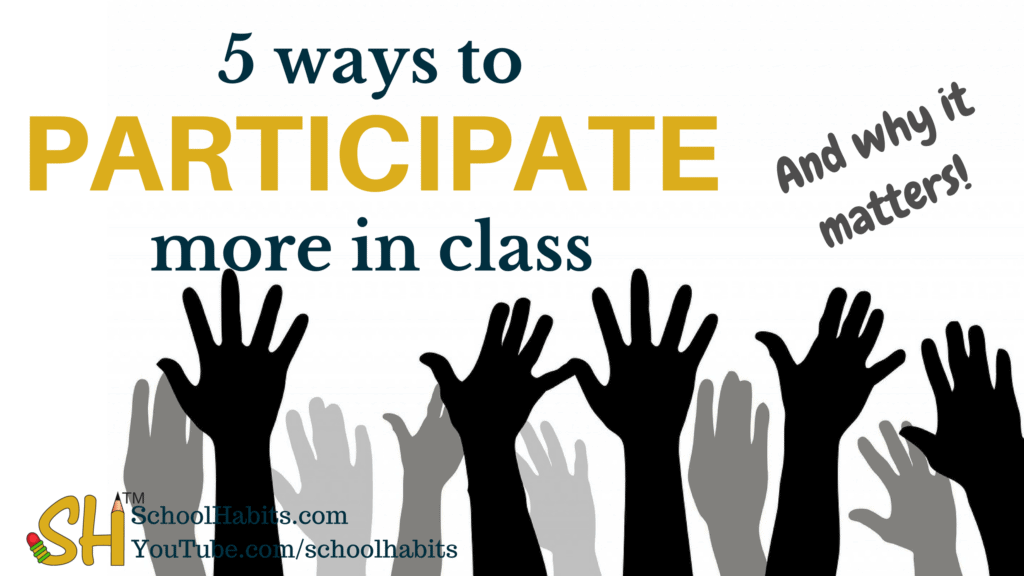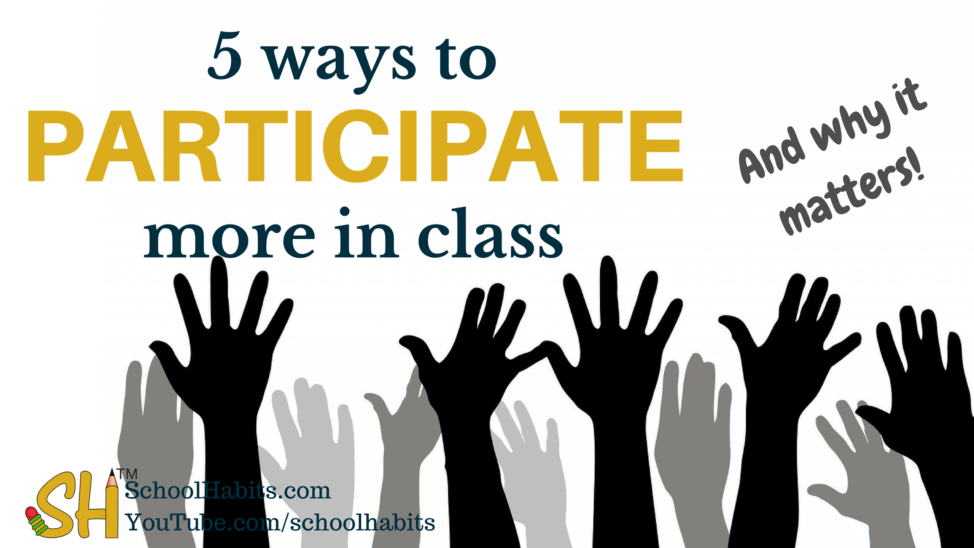
Some students are naturally inclined to participate more in class. These students participate either by raising their hand with a question or comment, or by volunteering for tasks or roles. These are often the kids with their hands in the air before the teacher even asks the question. And sometimes these are the students who blurt out their comments without even bothering to raise their hands — which is fine, of course, if the timing makes sense.
But not everyone is a “natural” at class participation, and there are a gazillion reasons why these students are reluctant to speak up in class.
Reasons why a student might avoid class participation:
- Anxiety
- Insecurity
- Not knowing the answer
- Fear of ridicule
- Fear of being wrong
- Desire to remain “under the teacher’s radar”
- Laziness (Ugh!)
Whether your teacher gives you a separate participation grade or not, I assure you that he or she will always factor your class engagement into your semester or final grade. If you’re the type of student who remains quiet for any of the above reasons (or for your own), you’ve got to make an effort to change your habits.
How often to participate in class
If you’re the student who never participates in class … ever … then your target goal is to speak up one time in every class. Try doing this for one week. It will get easier. The next week, aim to speak up twice now and again.
If you’re an occasional participator, raising your hand or speaking up only once in awhile, then your goal would be to increase the frequency in which you engage. Figure out where you’re starting at (once a class? once every few classes?) and then aim for just a little bit more.
Ultimately, the goal (depending on the class) is to engage in some manner (through questions, comments, volunteering, etc.) about three times in every class. Might sound nuts now, but I promise it gets easier after just one week of experimenting.
Also – if you participate more in class, you’ll stay more focused and avoid the awful “zone out” situation. Here are 7 strategies for not zoning out.
Once you make the (wicked smart) decision to participate more in class, you can use the strategies below to get started. At first, you might feel super awkward speaking up in class. You might even cringe at the sound of your own voice if you’re not used to hearing it in the classroom setting. (Kind of like that awful feeling when you hear your voice on a voicemail … tell me that’s not just me…?) But again, I promise it will eventually feel more natural.
5 ways in participate more in class
1. Think out loud.
No doubt there are times when you sit in class, and suddenly a relevant thought pops into your head. It doesn’t have to be a brilliant or perfectly formed thought, but still a thought.
Instead of keeping thoughts to yourself, raise your hand and “work out” the idea out loud with your teacher or classmates. It’s okay if it’s not a complete thought. It’s also okay if you begin with “I’m not sure how to phrase this, but …” Your teacher will likely pick up on what you’re trying to ask or say, and will fill in the blanks for you, especially if s/he sees you struggling to form your idea. A partial comment or question is better than nothing.
The trick is to speak up right when the thought pops into your head: don’t wait! If you wait, you’ll overthink it or second guess yourself.
2. Resort to HOW and WHY questions.
This strategy here is a shortcut. When you’re struggling to come up with a question or comment, you can always use the classic “Why?” or “How?” questions. Ideally, you wouldn’t just shout out “Why?!?!” but would instead complete the phrasing with some context. Something like: “Why did the character do that?” Or “How did the war affect the country 20 years later?”
Here’s a secret: You don’t even have to want to know the answers to the questions you ask. (Oh gosh, did I just say that?) But ask anyway! Asking these types of “staged” questions is excellent practice for speaking up, and a great way to get accustomed to hearing your own voice. Think of it as a dress rehearsal for the real questions and comments that you’ll eventually get really skilled at contributing.
3. Use “I wonder,” “I’m confused,” and “I want more” comments.
This class participation strategy is a great way to get your participation points without a lot of deep thought. As superficial as that might sound, these types of questions enhance class discussions because they encourage the teacher (or other students) to explain something in more detail, which helps you better understand the material.
These types of questions might look like this: “Can you please explain that a little more?” “Can you please explain that differently?” “I’m confused – could you please back up a bit?”
4. Share a relevant story.
When the teacher explains something to the class and it reminds you of “this one time when…” then speak up! If you can think of a story that’s related to the topic, absolutely raise your hand and share it. If your teacher talks about World War II, and your grandfather has some war memorabilia, tell the class about it. When your teacher explains the chemical reaction involved in volcanic eruptions (I’m assuming there’s some chemical action going on … not sure … not a scientist!), share a story about the time you visited a real volcano or something. These types of contributions to the class discussion are not only interesting, but can help you remember important information later on – through a cool process call association.
.5. Volunteer.
This one is self explanatory. When an opportunity comes up to be the group leader, write something on the board, or even pass out papers, take it! These gestures absolutely count as class participation.
What to do when raising your hand causes too much anxiety
If you struggle with how to participate more in class because raising your hand or speaking out loud gives you nearly paralyzing anxiety, then you can always write down your questions and physically give them or email them to your teacher after class. This still counts as class participation because it shows that you’re engaged with the class discussion.
But be honest here: we all get the jitters now and again when we speak in front a crowd and open ourselves up to be heard, but a typical “pit” in your stomach isn’t reason enough to not participate more in class. What I’m talking about here is legitimate, debilitating anxiety. If that’s not you, then raise your darn hand. Speak the heck up. Because no doubt you have something valuable and awesome to say.

